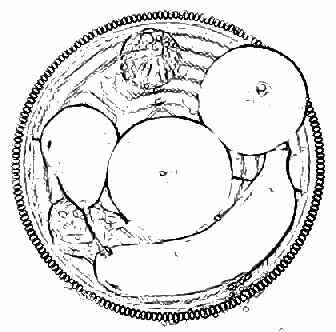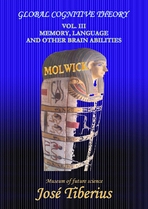THEORY OF MEMORY
1. Brain memory
The Memory, Language, and other Brain Abilities online book is the third chapter of The Global Cognitive Theory. Consequently, it is highly recommended to read the previous two books for a better understanding of the given proposals and concepts.
The introduction of the first one, Brain and Modern Computers, elucidates the Global Cognitive Theory is a consequence of the application of the General Theory of Conditional Evolution of Life to evolutionary psychology.

It also contains a small summary of the Global Cognitive Theory.
Besides describing a general scheme of the cognitive functions of the brain, the Brain and Computers book states the concept of intelligence needs the memory and vice versa.
The interrelation between intelligence and memory suggests an additional reason for the suitability of reading the Intelligence, Intuition, and Creativity book.
The essay about intelligence has two sections with direct repercussions on the memory and language theory. On the one hand, the knowledge management model with the elegant intelligence help to classify the memory from the perspectives of the reliability and reaction time, and the temporal horizon. The other substantial section refers to the genetic character of the cognitive functions, like intelligence and memory.
The second chapter of the Memory, Language, and other Brain Abilities book relates to the exciting topic of how to improve memory from a realistic perspective of the non-existence of miracles or supernatural improvements. However, it roughly points out how to help the natural brain working; which would be more efficient the better the functional structure is known, or the evolutionary psychology understood.
The next chapter discusses the types of memory, analyzing the conscious processes and the temporal horizon separately. Among the first types would be the instantaneous memory and the specialized ones, which have particular characteristics, like the visual, semantic, or emotional memory. Concerning the temporal horizon, it discusses the traditional distinction of the short, medium, and long-term.
It also expresses two subjects about the reliability and integrity of memory. Whereas the second book of Cognitive Global Theory debates the consistency of the answers given by the memory manager, which is the intelligence; regarding the integrity of information, one must analyze the unconscious mechanisms of compression, degradation, and reconstruction of the data.
The fourth chapter studies the mechanisms of conscious optimization curry out by the brain and the influence of the environmental conditions. It uses the expressions guided memory and automatic memory to emphasize the possibilities of affecting the cited mechanisms of optimization.
Moreover, it describes strategies used by the brain to improve the management of the information, like the dynamic memory or pre-established packages, and to memorize only the opposite to the logic.
The last section refers to evolutionary genetics and neuroscience; it comments the limitations of conceivable statistical research similar to the EDI Study but on memory.
In particular, the problems of the statistical analysis on genetics and memory are due to the different types of memory, the lack of quality indicators and the effects of complementarity, owed to the interaction between the intelligence as the information manager and the cognitive ability to store the information.
Once we have an overall view of the cognitive function of the memory, we go further and try to explain the extreme power of the language, the semantic memory, and verbal reasoning.
Finally, we add some considerations on the genetics of the language and its evolution.
